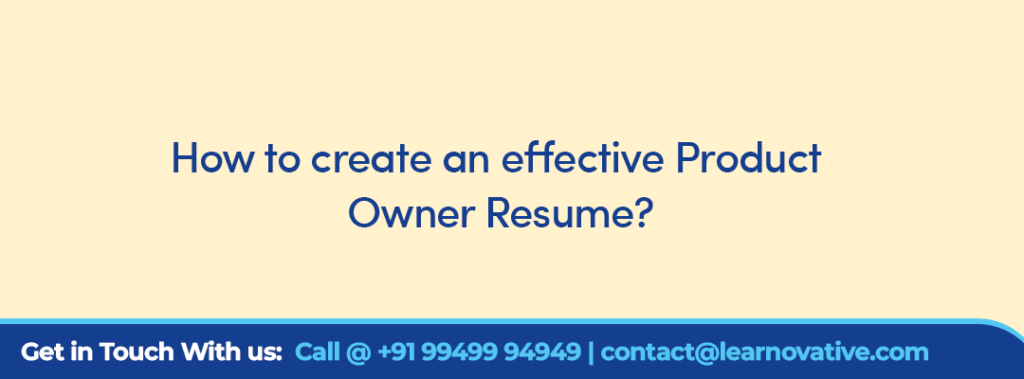
The Product Owner is like the captain of the Ship. Hence building a powerful and effective resume is important for a Product Owner to secure challenging opportunities in erupted organizations. This article helps you to understand some important tips to create your Product Owner resume.
Keep it short and simple:
Do not create more than 2 to 3 pages for your Resume. The longer your resume is, the lesser it will be shortlisted. So try to organize your resume within maximum of 3 pages and keep important and critical information on that. You can leave some additional information in the form of web links to your personal website, Linked in profile, or any other source.
Resume sections are the key:
What sections you will keep in your resume is highly important to get shortlisted by the recruiters. Segregating your professional experience into different sections as per their importance is critical. Prioritize the content into Critical, Important and Additional sections and try to fit the Critical information in the first page of your resume. You can consider the following sections under these three categories:
Critical:
- Executive Summary
- Certifications
- Achievements
- Professional Experience
- Contact Information (Email & Phone)
Important:
- Educational qualifications
- Strengths
- Domain experience
- Tools experience
Additional:
- Project experience
- Recommendations
Keep it aligned with the Job Description:
One common mistake most of the people do is, they do not keep their resume up-to-date. They create one version and just share the same for different job openings. This may not really help you. Depending on the job you are going to apply for, the content of your resume should be aligned according to the job description. Referring to the key words used in the Job Description in your resume will get more probability of being picked up by the recruiter. At the same time, do not try to cook up the experience just to match the job description. At the end, you want to be successful in the role if you are selected.
Objective/Executive Summary should be powerful:
This section is not just a list of your previous product owner responsibilities. It is meant to present you as a wholesome candidate by highlighting your relevant accomplishments and should be customised specifically to suit the particular product owner position you are applying to. This section should help the recruiter understand a few important points:
- Why are you the most suitable person for that role?
- How does this job align with your career goals?
- What specific experience or skills make you the perfect fit for this role?
For example: Instead of mentioning “I am an seasoned and experienced Product Owner looking for challenging opportunities to demonstrate my skills”, it will be powerful if you mention “A “CSPO” Certified Product Owner with 8 years of Product Owner experience, doubled the ROI of XYZ Product (from 1M$ to 2M$) through innovative features, regular customer feedback and value based prioritization ”
This helps recruiters understand your experience and they will have confidence in your caliber.
“What” is common, “How” is critical:
Majority of the resumes will miss this point. They focus more on “What” they do, but they forget to mention “How” they do “What” they do. If you can clearly explain how you do what you do, the recruiter will have a fair understanding of your skills and experience. You can consider the below examples:
Instead of mentioning just “Interacted with Customers”, it will be nice if you include how you interact with your Customers as given below:
- Regular interactions with Customers using Customer Meetup, Focus Group Discussions, Surveys and Interviews to better understand their needs
- Invited critical Stakeholders to Sprint Reviews to get Early Feedback and enhance Transparency
Instead of mentioning just “Worked closely with Development Team”, it will be good if you include how you have worked with your Development Team as given below:
- Conducted User Story Writing Workshops with Story Map technique
- Actively involved in Product Backlog Refinement to lead the Activity by providing clarity to the team on the upcoming Product Backlog Items
- Participated in Sprint Planning to help Development understand the Business objective for the Sprint
Do not mix up roles and experience:
This is one common mistake people make in preparing their resume. They try to mix the experience of various roles like project manager, Business Analyst, Technical Architect, with Product Owner. This creates confusion in the recruiter and they cannot evaluate your experience as it is focusing on many roles so it leads to diluting the purpose.
So, if you are applying to a Product Owner role, then focus on your Product Owner experience, knowledge and skills and achievements. Keep the additional roles’ details in a separate section just for reference.
Highlight the achievements right way:
Recruiters look for people who are results oriented, so they look for instances of such results in your resume. So keeping the details of your achievements in your existing job in the right way is important. Examples are below:
Instead of listing the below way:
- Worked as Product Owner in the last 2 years and delivered 2 Products
- Worked with 3 Development Teams
It will be better to mention as below:
- Delivered new Salesforce CRM customization Product by taking complete responsibility from Vision, Roadmap, Backlog Management, Release Planning,
- Led 3 Developments teams by ensuring they have visibility on the right priority, clarity on the requirements, and made myself available for them throughout the Sprint to provide clarifications and to validate the work done by the team.
How to make statements more powerful in your resume?
Below are some example statements that help you to frame sentences in your resume
- Created Product VIsion for the AI Driven Mobile application using Product VIsion Poster
- Prepared Product Strategy using Business Model Canvas
- Validated the Product-Market fitment using Value Proposition Canvas
- Conducted Focus Group Discussions to gain insights of customer needs for the upcoming release and converted them into Epics and Features, and prioritized them using DOT voting technique with the Customers
Conducted Story Writing Workshop with my team to drill the features into User Stories and used Story Mapping Technique
Recent Posts
- Essential Metrics to Measure Scrum Team Performance 17/04/2024
- How to influence without Authority? 17/04/2024
- Impact Mapping Example 08/04/2024
- Business Agility Vs Organizational Agility Vs Enterprise Agility 08/04/2024
- Agile Vs agile vs Agility 28/03/2024

